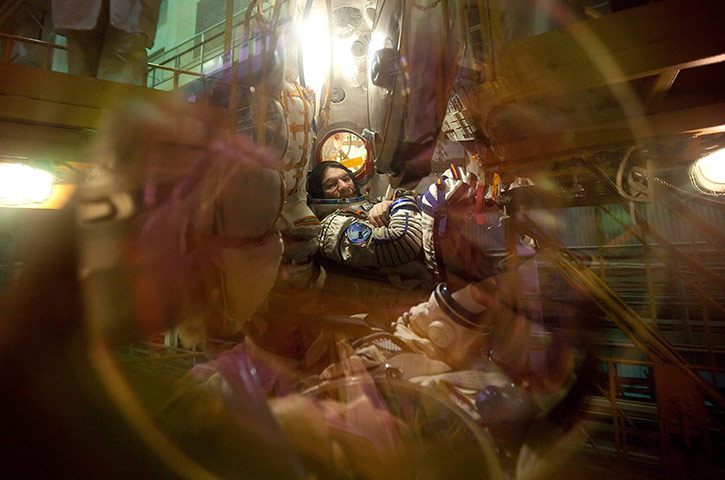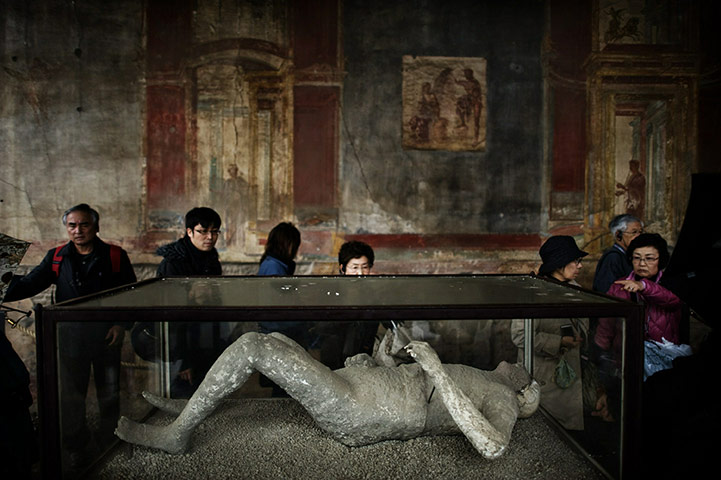Not long after the mass suicide at Jonestown in 1978, a friend remarked casually, “That’s why we shouldn’t have space colonies.” This was not the typical connection made at the time, and he spoke primarily as a critic of NASA’s “manned” space program, but it spoke volumes about the tendencies that had driven the unfortunates to their deaths: fleeing the center to create an enclaved community, the strange cult proved to be all too American after all.
The story came to mind again when I saw this photograph from the European Space Agency.

He’s Italian, not American, and he’s all alone, not part of a group, and he’s working for an organization of highly trained professionals, not an authoritarian dictatorship, so what’s the point of the comparison? Well, take a look. The astronaut lies confined to his space suit, almost immersed in it, and moving, seeing, and even breathing now seem barely possible because of the equipment that allows him to live at all. His head is framed by two portals: the round window behind him to the outside of the Soyuz TMA-20 spacecraft, and the one in the foreground through which we peer into the dim interior with its cluttered material and garish lighting. This is an image of confinement, and also of the long term consequences of confinement while being hurled, centrifugally, into space. We see him both as he is now in the test space, and as his successors might become after many years of exploration far removed from Earth. Grown into machines that both sustain and entomb them, cut off from all the interaction and change of social life outside the bubble, left to the growing madness induced by the repetitive immobility of the colony, anything becomes possible while the prospects of remaining human become ever more dim.
Thus, an image from the modernist dream of advancing humanity to the stars has a dystopian hue. Instead of touching the heavens, space travel looks decidedly claustrophobic. It looks, one might say, like the past.

This image of a body cast from Pompeii has some obvious affinities with the one above, and also a few notable differences. Again we see a single body immobilized, now with its head caught in a last effort to breathe and perhaps to see the cause of its destruction. The body is framed by its rectangular enclosure of glass, which is mirrored by the framed figures in the background, and so we see it between two portals, one to the interior space and another to the society that had surrounded it. The most important differences are that the trappings of modern civilization are here replaced with the decor of antiquity, and spectatorship has been changed from looking through a single aperture to several tourists also on display. Here the past has been excavated, but only to be entombed again. This is not Pompeii as it was then, a lively resort town, but the post-catastrophe ruin that silently cautions any civilization living on the edge of sustainability.
Not to put to fine a point upon it, but whether one looks to the future or the past, there is reason to see disaster as a real possibility–and one that exists not because of some unforeseen factor, but precisely because of who we are and how our society is organized. Affluent Romans went to Pompeii to get away from the cares of the city–nothing wrong with that, but they couldn’t escape nature’s fury. Space colonies are imagined as distant projections of our best selves, when they could become hellholes only likely to end well as monuments to isolation. Neither are real options, but the tendencies they represent are constantly evident in contemporary decision-making.
The challenge today is not to stretch toward a distant future, no more than it is to merely stare at a long-dead past. Far more difficult is the task of taking the present seriously, and to see the present as belonging to everyone rather than those able to move into enclaves of privilege. Indeed, unless there is a significant re-orientation in public policy toward the concerns of a common present, the future will already be like the past: entombed by catastrophe.
Photographs by Sergei Remezov/Reuters and Roberto Salomone/AFP/Getty Images.
This post makes me very curious about where you’re getting your ideas about space exploration and colonization.
“Instead of touching the heavens, space travel looks decidedly claustrophobic.” Do you believe this will be the case indefinitely?
“Space colonies are imagined as distant projections of our best selves”…by who?
Wouldn’t you say that image looks claustrophobic? As for the imagination of space colonies, I’d cite a century or more of science fiction–while granting that genre includes many dystopian (including claustrophobic) visions–as well as the public discourse of NASA, the multi-media productions of Disney World, and various official testimonies such as Reagan’s Challenger Address.
The first few paragraphs about space colonization evokes first few scenes from an interesting sci-fi movie|anime. I wonder if you would flesh them out to a short story or a novel.
Yes, rest of the text about Pompeii was not as interesting to me in comparison.